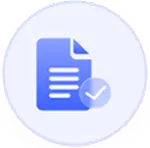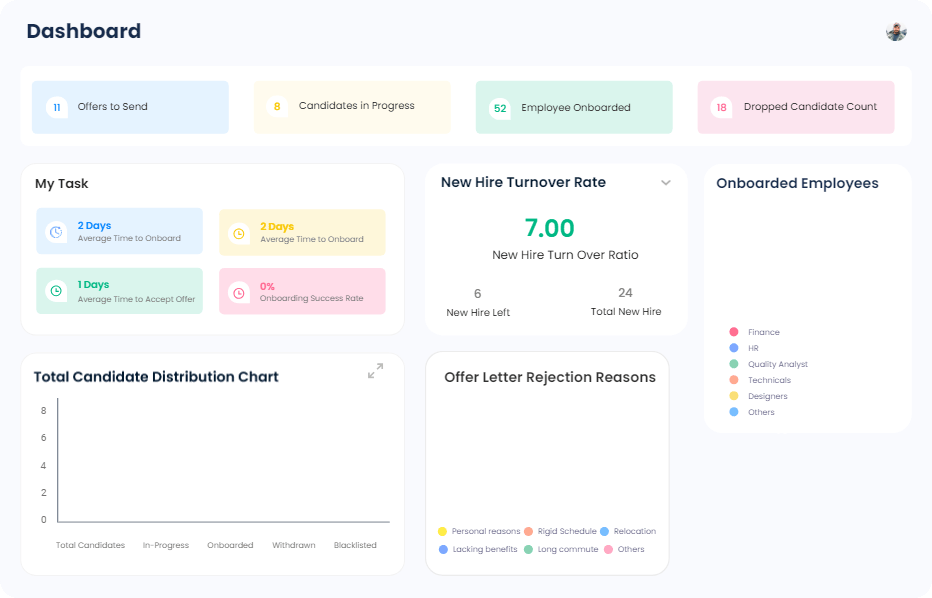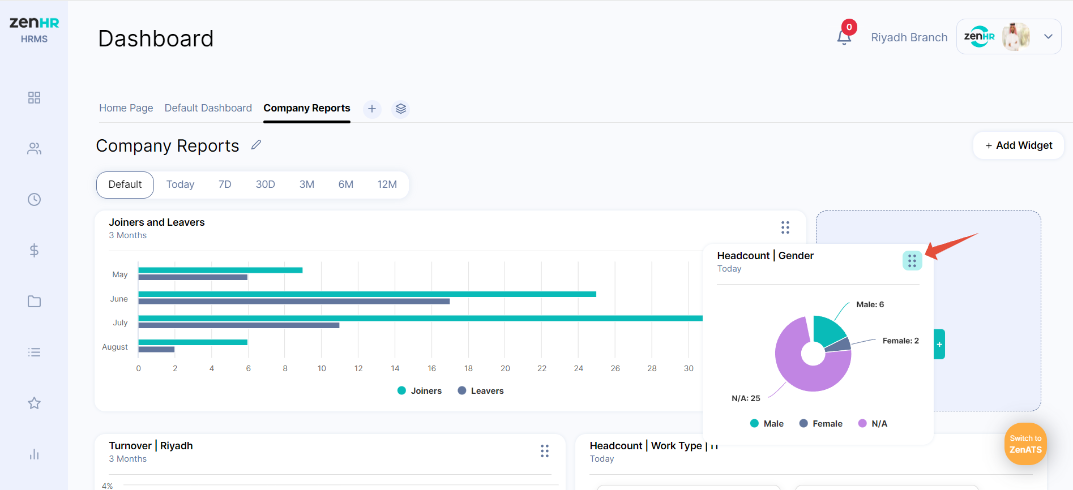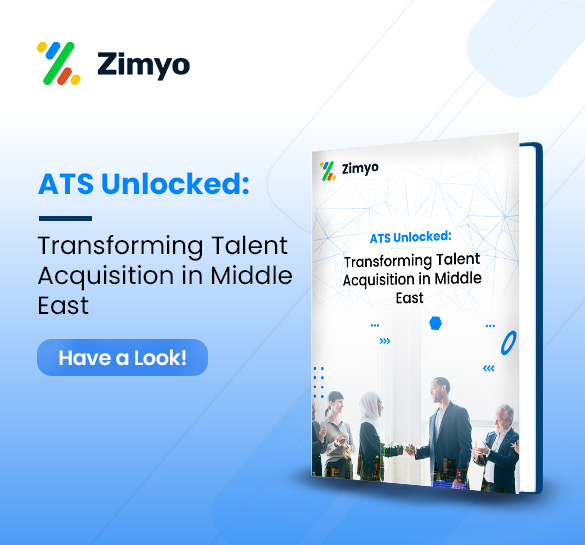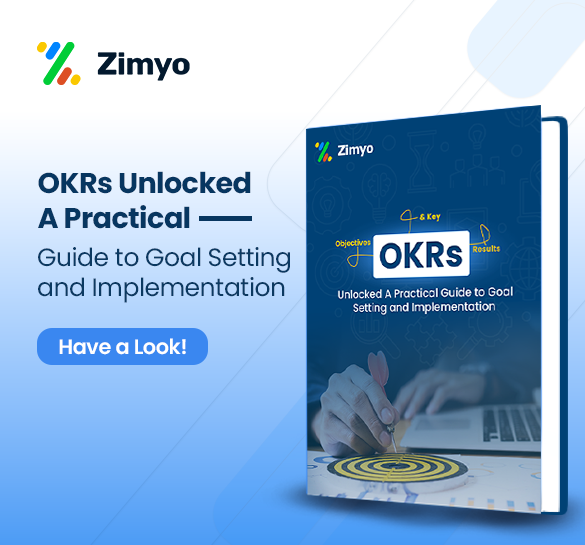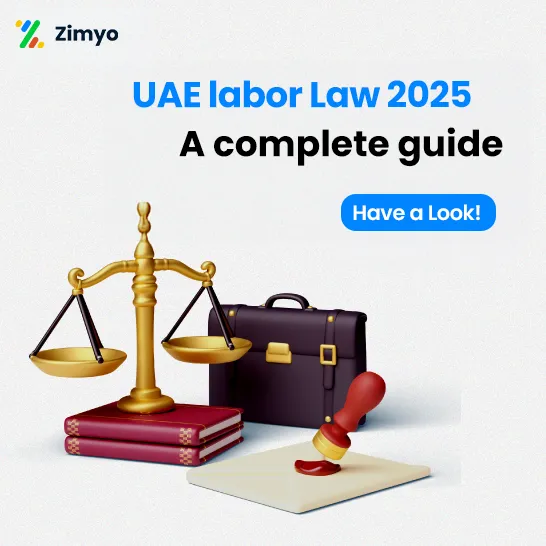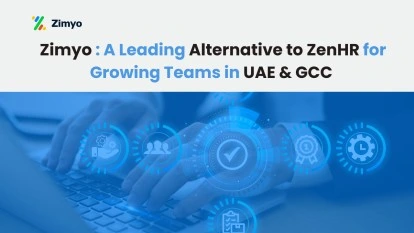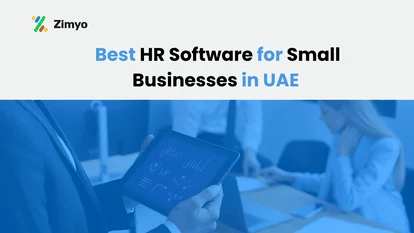In 2025, as companies in the UAE, Saudi Arabia, Bahrain, Oman, Kuwait, Qatar, and Egypt scale up, the demand for more than just basic HR tools is very strong. Organizations are looking not only for payroll and attendance management but for fully integrated, AI-driven, scalable HRIS software that can handle onboarding, performance, engagement, compliance, and cross-country labor law diversity. While ZenHR (Zen HR) has been a GCC HR software space, many businesses are now evaluating ZenHR alternatives & similar software that provide more automation, better modular flexibility, and deeper regional compliance. Among these, Zimyo stands out as one of the top alternatives to ZenHR.
Below is a side-by-side analysis: Zimyo vs ZenHR, their features, USPs, and why many growing teams are picking Zimyo. This should help you see whether Zimyo is the right fit HR software in UAE for you.
- Zimyo is a comprehensive HR software in UAE focused on the full employee lifecycle: hiring, onboarding, attendance, payroll, performance, employee engagement, asset & expense management, LMS, etc. Multiple sources note it has 50+ modules for HR operations.
- It is designed for the GCC / MENA region: supports Arabic & English, WPS compliance (in UAE), regional payroll laws, local labor law compliance for different GCC countries.
- It offers mobile-first, self-service employee and manager portals, real-time dashboards and analytics, and automation of workflows (onboarding, approvals, offboarding, etc.).
- It is used by a large number of organizations in the region (often “2500+ organizations” in several references).
About ZenHR
- ZenHR is a cloud-based HRMS built for the Middle East region, offering bilingual support (Arabic/English) and focusing on features like core HR, payroll/WPS, recruitment, leave & attendance, employee self-service, mobile app, etc.
- It is well-known in the UAE and wider GCC; many SMEs and mid-sized companies use ZenHR for typical HR needs—payroll, leave, attendance, onboarding workflows.
- It also provides basic reporting and analytics to help HR teams track workforce trends and compliance.
Feature Comparison: Zimyo vs ZenHR (ZenHR Competitors & Alternatives)
Here is a comparison across key HR system modules, showing where Zimyo tends to lead (and where ZenHR might still excel, or be comparable):
Module / Feature | Zimyo | ZenHR |
Payroll & WPS compliance | Strong, automated; supports regional payroll requirements (UAE + cross-GCC) including generation of WPS/SIF files, gratuity, deductions, allowances etc. | Good payroll support; WPS compliance; multi-currency depending on country; simpler setups in many cases. |
Onboarding & Offboarding / Workflows | More configurable, automated, paperless workflows, approvals, checklists, etc. Zimyo emphasizes workflow customisation. | Offers onboarding workflows; possibly less depth in some automated / AI-driven steps (but strong for its size). |
Recruitment / ATS | Zimyo has an ATS component, AI-driven candidate screening, integrations with job boards etc. “ATS unlocked” report shows real-time candidate tracking, faster hiring cycles. | ZenHR also provides recruitment module; however, user feedback suggests fewer advanced AI screening features. |
Attendance / Time Tracking | Geo-tagged attendance, mobile check ins, shift/roster management, integration with payroll etc. | Strong leave & attendance tracking; many features similar; possibly fewer advanced analytic features or mobile / geo-tagging in lower-tiers. |
Performance Management / OKRs / Engagement | Zimyo tends to offer continuous feedback, OKRs, performance tracking, employee engagement tools, surveys, recognition etc. | ZenHR has performance appraisal modules; engagement features; but reviews suggest Zimyo may have more frequent updates and broader engagement tools. |
Analytics, Dashboards & Reporting | Real-time dashboards, user-definable reports, deeper analytics including payroll cost, turnover etc. | ZenHR provides dashboards and reports; in many reports its analytics are described as adequate but sometimes less advanced or flexible. |
Mobile & Employee Self-Service | Strong mobile-first design; employees can view payslips, request leave, manage personal data etc. via mobile. | ZenHR also has mobile app / ESS; functionality is good; sometimes interface or speed depends on plan. |
Multilingual (Arabic / English) | Full support; built for GCC region with Arabic interface. | ZenHR likewise provides bilingual support as one of its known features. |
Modularity / Scalability / Multi-Country | Zimyo seems more aggressively modular with many modules; designed for multi-country operations, labour law differences. Also supports many GCC jurisdictions. | ZenHR does aim for regional compliance; but multi-country features may be less flexible or may require custom configuration / heavier support. |
Cost / Pricing | Zimyo is often cited as cost-effective, transparent pricing, competitive for SMBs and mid-sized firms. Because of its many modules, the cost might increase when advanced modules are used. | ZenHR’s pricing tends to be custom, possibly lower entry cost for basic plans; but as you scale and need more modules / add-ons, cost may rise. |
Empower Your Workforce; Zimyo Manages HR End-to-End
USPs & Strengths: Zimyo as alternative to ZenHR
While both are strong, some USPs for Zimyo that often tip the decision in its favor, especially for growing teams in 2025:
1. Greater Automation & Advanced Features
Zimyo invests in AI-driven tools (screening, reminders, workflow automation) and less manual work. Although ZenHR offers automation, Zimyo seems to push more frequently into advanced territory.
2. Deep Regional / GCC Compliance
For companies operating across more than one GCC country, or planning to expand, Zimyo’s compliance coverage across UAE, KSA, Bahrain, Oman, Kuwait, Qatar etc., is often seen as more “plug-and-play”. Whereas ZenHR is strong, but sometimes heavier customisation is needed for non-UAE jurisdictions.
3. Modular Flexibility & Scalability
As your team grows, your HR needs change (e.g. performance tracking, learning & development, expense / assets / travel). Zimyo’s large module set (50+) allows adding features gradually.
4. Employee Experience & Self-Service Emphasis
Zimyo’s mobile-first, employee self-service, better interfaces and faster support are appreciated by many users. Employee engagement tools, continuous feedback mechanisms, surveys etc. are often more developed.
5. Stronger Analytics & Real-Time Reporting
For leadership and HR managers making data-driven decisions, Zimyo’s dashboards and reporting are often cited as more flexible, more real-time, and more granular.
6. Transparent Pricing & Cost-Effectiveness for Mid-Size Growth
For growing teams (say 50-500 people), Zimyo tends to give more value per feature, especially if your growth path includes multiple GCC countries or cross-jurisdiction compliance.
7. Rapid Feature Development & Support
Users often report quick response from Zimyo’s support; faster addition of new features. Also, more “future looking” modules (e.g. AI screening, expense automation, L&D) included vs being add-ons.
Over 60% of UAE SMEs are adopting cloud-based HR solutions for flexibility and scalability. Many platforms allow employees to manage leave, personal info, and attendance, reducing HR workload by up to 30–40%.
Pros & Cons
Given below are the pros & cons of both the software-
Zimyo – Pros & Cons
Pros | Cons |
Advanced automation: AI-driven workflows, recruitment, onboarding | Higher initial cost for full suite |
Comprehensive HR modules (50+): payroll, attendance, performance, engagement, LMS, assets, expenses, helpdesk | Can be overkill for small teams with simple HR needs |
Multi-country GCC compliance, including UAE WPS |
|
Scalable & modular: add modules as the organization grows | Potential complexity in module configuration |
Mobile-first employee self-service & engagement tools |
|
Real-time dashboards & analytics for leadership & HR |
|
Transparent pricing & cost-effective for mid-sized teams | – |
Rapid feature development & responsive support | – |
Your Entire HR Journey, Simplified with Zimyo
ZenHR – Pros & Cons
Pros | Cons |
Strong core HR features: payroll, leave, attendance, onboarding | Limited automation compared to Zimyo |
UAE-focused: simple setup for local operations | Fewer advanced modules (LMS, asset/expense management) |
Lower entry cost: affordable for small teams | Multi-country compliance requires customization or add-ons |
Bilingual support: Arabic & English | Analytics less granular; fewer real-time insights |
Mobile app & employee self-service | Scaling beyond basic HR may increase cost and complexity |
Adequate for small-to-medium UAE operations | Less AI-driven recruitment & workflow automation |
Cost & ROI Considerations
Total Cost of Ownership: In Zimyo, while core features are cost-effective, additional modules (such as ATS, L&D, Engagement, Expense, etc.) increase cost. But still may be less than patching together multiple solutions, employing additional HR personnel, or having compliance risk in operating manually.
Time & Administrative Savings: Payroll, attendance, onboarding etc. automation saves significant HR time, lowers error rates, enhances compliance (minimizing penalties).
Employee Satisfaction & Retention: Improved UX, engagement tools, feedback, self-service tends to elevate morale and decrease turnover.
Scalability: Selecting a tool that will grow with you (i.e. additional countries, regulations, employees) is typically less expensive in the long term than having to change platforms once you outgrow them.
Organizations using automated payroll systems reduce errors by up to 80% compared to manual processing. Companies with employee self-service portals report 30–50% faster leave approvals and fewer HR queries.
Feature Comparison Matrix: Zimyo ZenHR Alternatives & Similar Software
To make things clear, here’s a detailed matrix of features and how Zimyo compares with ZenHR (often based on user reviews, industry comparisons, and product listings):
Feature / Capability | Zimyo | ZenHR |
Core HR | ✅ | ✅ |
Payroll automation | ✅ | ✅ |
Leave & Attendance tracking | ✅ | ✅ |
ATS / Recruitment / Resume parsing | ✅ | ❌ |
Onboarding automation | ✅ | ❌ |
Performance management & continuous feedback | ✅ | ❌ |
Employee engagement tools | ✅ | ❌ |
Mobile app & Self-Service | ✅ | ✅ |
Multilingual support | ✅ | ✅ |
Analytics & Reporting | ✅ | ❌ |
Compliance & Multi-Country Labour Law Support | ✅ | ❌ |
Asset management | ✅ | ❌ |
Expense management | ✅ | ❌ |
Travel management | ✅ | ✅ |
Learning Management System | ✅ | ❌ |
Helpdesk / Ticketing | ✅ | ✅ |
AI-driven recruitment screening | ✅ | ✅ |
Workflow automation | ✅ | ❌ |
Customizable dashboards & reporting | ✅ | ✅ |
Employee recognition & reward programs | ✅ | ❌ |
Rapid feature updates & support | ✅ | ❌ |
Modular scalability | ✅ | ✅ |
Integration with multiple job boards / external tools | ✅ | ❌ |
Real-time payroll & HR analytics | ✅ | ✅ |
Cross-GCC payroll compliance | ✅ | ✅ |
Streamline Every HR Step with Zimyo
Why Choose Zimyo as alternative to ZenHR
Putting it all together, for growing teams (SMEs to mid-sized organisations) in UAE / GCC who are planning to expand, need stronger HR automation, want to reduce manual effort, ensure compliance early, and provide modern employee experience, Zimyo is very compelling. Here are reasons why many are shifting toward Zimyo:
- Although ZenHR is strong in core HR and payroll, Zimyo provides further automation in recruitment, onboarding, workflows, recognition, and continuous feedback, which reduces HR effort even more.
- Additionally, Zimyo has a larger number of modules (assets, expenses, LMS, helpdesk etc.), which means that organisations do not have to depend on more than one tool or workarounds by hand.
- In addition, for businesses that are active in more than one GCC state, Zimyo’s extended regional compliance assistance is a significant advantage—it accommodates different labor law needs, regulations for payroll, and statutory obligations more easily.
- Also, employee self-service, mobile-first design, employee engagement tools and surveys are generally more sophisticated in Zimyo, facilitating retention, morale, and HR efficiency.
- Also, with real-time dashboards and analytics, leaders are able to make more informed decisions, identify issues in hiring, turnover, payroll cost etc., instead of waiting for regular reports
- In addition, cost savings for scaling teams: beginning with essential modules and expanding as necessary aids in budget control; also, the ROI (in time saved, fewer errors, compliance risk) can easily pay for itself.
- Also, future-proofing: as labor regulations improve, as businesses grow, as remote/hybrid and mobile work grows more prevalent, tools that can be flexible, update-friendly, and modular mean a great deal—and Zimyo seems to put more emphasis on these areas.
Over 70% of GCC companies plan to digitize HR processes in the next 3 years to improve efficiency and compliance.
Extended Comparative Narrative: Zimyo vs ZenHR in Practice
To better imagine this, here’s how an expanding company might experience the difference when utilizing Zimyo vs ZenHR, particularly as they get larger or grow.
Scenario: 20-man tech start-up in Dubai grows to 100 people in one year; then sets up second office in Riyadh (KSA); plans to hire more, enhance performance management, minimize payroll errors, enhance employee experience, and manage costs/assets centrally.
Year one, ZenHR does the job: compliance of payroll in UAE, attendance, tracking of leaves, simple performance reviews, onboarding, mobile Employee Self-Service. Low to moderate cost; minimal training required.
But when the team is larger, they desire more: asset / expense tracking, learning & development, employee surveys & engagement, refined onboarding workflows, cross-office payroll (KSA), stronger analytics.
With Zimyo: these modules are ready; compliance in KSA already or in the process of updating; dashboards reflect turnover, cost per hire etc.; mobile app is good; employees can enter expense claims through mobile; managers have real-time information; HR takes less time for manual reconciliation.
Cost: initial expense of having all these modules in ZenHR can involve adding lots of add-ons, custom setups, or third-party tools. Zimyo can have higher up-front investment for full suite, but has tendency to offer more built-in features and less operational drag (less manual effort, less errors, less compliance risk).
Conclusion
In short, Zimyo is among the strongest ZenHR alternatives and top ZenHR alternatives & competitors in UAE / GCC in 2025. For growing businesses, multiple-country operations (or soon-to-be), strong HR automation, employee experience, and scalability needs, Zimyo provides more future-proofing.
For organizations seeking a solution that combines automation, employee experience, and scalability, Zimyo provides a more future-proof approach compared to ZenHR.
Schedule a demo today and discover how Zimyo can transform your HR operations, streamline processes, and empower your workforce.
From Hire to Retire—Zimyo keeps You Covered
Frequently Asked Questions (FAQs)
Zimyo is among the best ZenHR alternatives, offering a full-suite HRMS with stronger automation, wider module flexibility, Arabic support, and deeper regional compliance.
Besides Zimyo, other competitors & alternatives include Bayzat, GulfHR, Zoho People, and peopleHum. But for automation + multi-country HR + full lifecycle modules, Zimyo often stands out.
Yes, for mid-market SMBs who need core HRMS functionality and match the higher AI capabilities.
Yes, Zimyo offers free demos / trials for companies to test features, see regional compliance, and compare with other HR software like ZenHR. (As is typical for HRIS vendors in UAE / GCC.)
Key features: ATS & AI screening, onboarding automation, payroll and WPS / multi-GCC compliance, mobile ESS, employee engagement tools, modularity (assets, expenses, LMS etc.), dashboards & real-time analytics, multilingual support.
Zimyo, for sophisticated analytics, AI-based HR management, and enterprise-level automation.


















